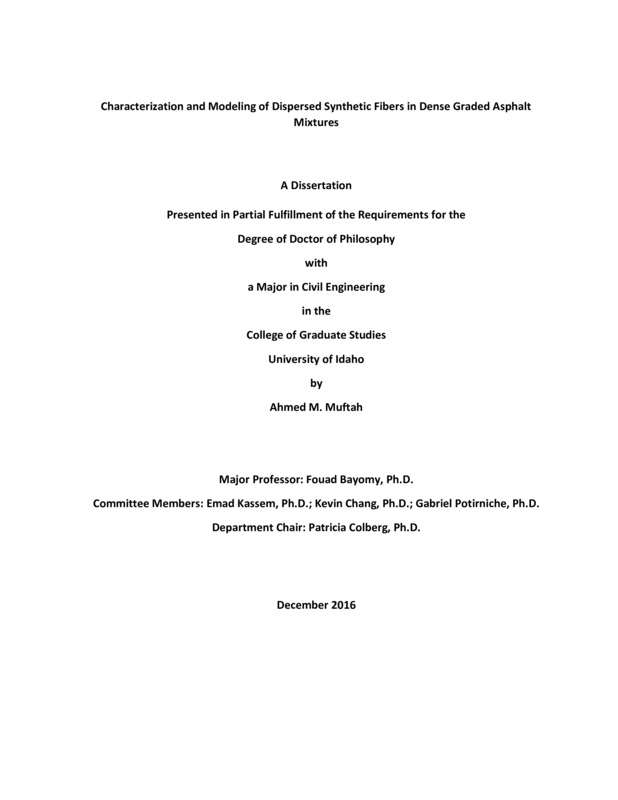Characterization and Modeling of Dispersed Synthetic Fibers in Dense Graded Asphalt Mixtures
Muftah, Ahmed. (2016). Characterization and Modeling of Dispersed Synthetic Fibers in Dense Graded Asphalt Mixtures. Theses and Dissertations Collection, University of Idaho Library Digital Collections. https://www.lib.uidaho.edu/digital/etd/items/muftah_idaho_0089d_10058.html
- Title:
- Characterization and Modeling of Dispersed Synthetic Fibers in Dense Graded Asphalt Mixtures
- Author:
- Muftah, Ahmed
- Date:
- 2016
- Embargo Remove Date:
- 2017-12-20
- Keywords:
- Fibers Hot Mix Asphalt
- Program:
- Civil Engineering
- Subject Category:
- Civil engineering
- Abstract:
-
The premature deterioration of hot mix asphalt pavements is one of the common issues concern many transportation agencies. Innovative solutions are needed to enhance the serviceable life of pavement. Various techniques are widely utilized. One of the most popular and common methods is fiber reinforcement.
Fibers have been used extensively in Portland Cement Concrete (PCC) since 1950’s. However, use of fibers in asphalt mixtures is relatively new. There are limited studies that investigate the effect of fibers in asphalt mixtures. Some laboratory testing showed that fibers improved the resistance of asphalt mixtures to rutting and fatigue. However, these investigations did not provide a comprehensive understanding of the interaction mechanism between asphalt mixture constituents and fibers. The goal of this research was to evaluate and quantify the effect of fibers on the mix performance characteristics. Furthermore, the research aimed at evaluating the healing characteristics, developing a method to detect the fiber dispersion in the mix and to develop a finite element model (FEM) to study the resistance of fiber-modified asphalt mixtures to permanent deformation.
Three types of synthetic fibers were used. Fiber #1 (aramid and polyolefin fibers), fiber #2 (a wax treated aramid fiber) and fiber #3 (glass fiber). A number of laboratory tests were conducted on laboratory-prepared test samples and extracted field cores. A FEM model to simulate the accelerated performance test was developed and was calibrated using material parameters from direct laboratory testing. X-ray tomography was used to evaluate and quantify the level of fiber dispersion in the mix.
The results show slightly improved performance at higher fiber contents than those recommended by the manufacturers. Asphalt healing study revealed that presence of fibers has increased healing rate and consequently delayed fatigue damage. The developed finite element model (FEM) can be used to predict a long-term rutting performance of asphalt pavements. It was found out that X-ray tomography was not suitable to detect fiber dispersion. An optical image processing technique in conjunction with a lab-based method using UV light was developed and found to be more successful to evaluate the fiber dispersion in the mix.
- Description:
- doctoral, Ph.D., Civil Engineering -- University of Idaho - College of Graduate Studies, 2016
- Major Professor:
- Bayomy, Fouad
- Committee:
- Kassem, Emad; Chang, Kevin; Potirniche, Gabriel
- Defense Date:
- 2016
- Identifier:
- Muftah_idaho_0089D_10058
- Type:
- Text
- Format Original:
- Format:
- application/pdf
- Rights:
- In Copyright - Educational Use Permitted. For more information, please contact University of Idaho Library Special Collections and Archives Department at libspec@uidaho.edu.
- Standardized Rights:
- http://rightsstatements.org/vocab/InC-EDU/1.0/

